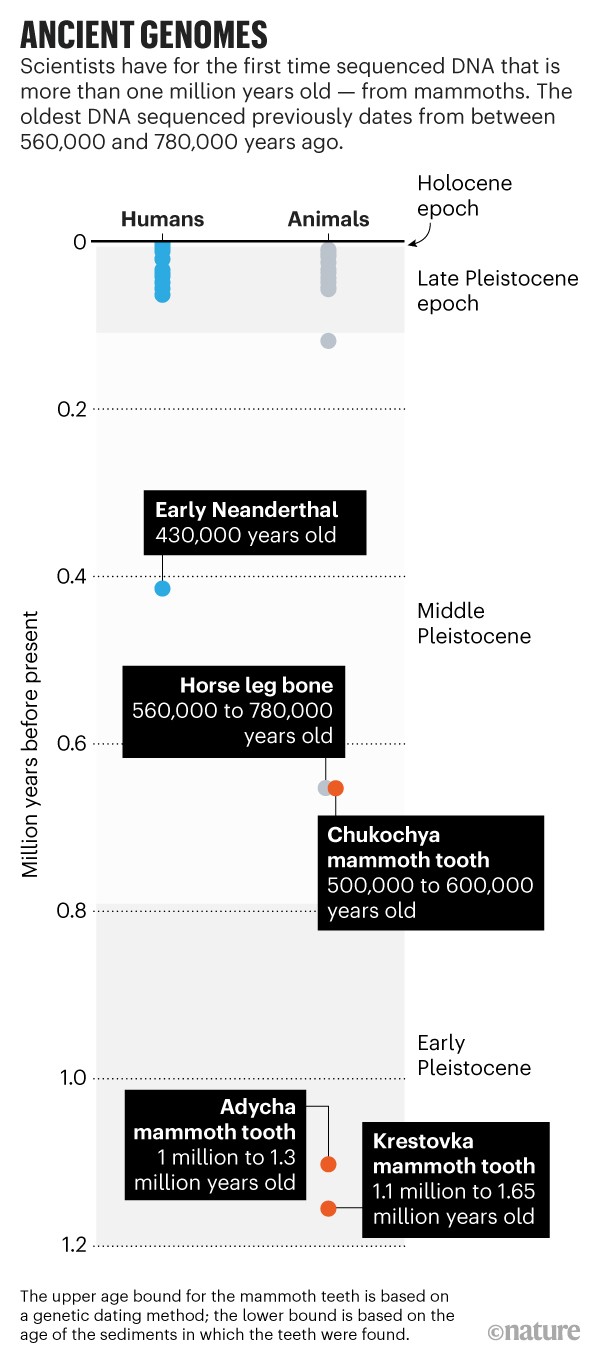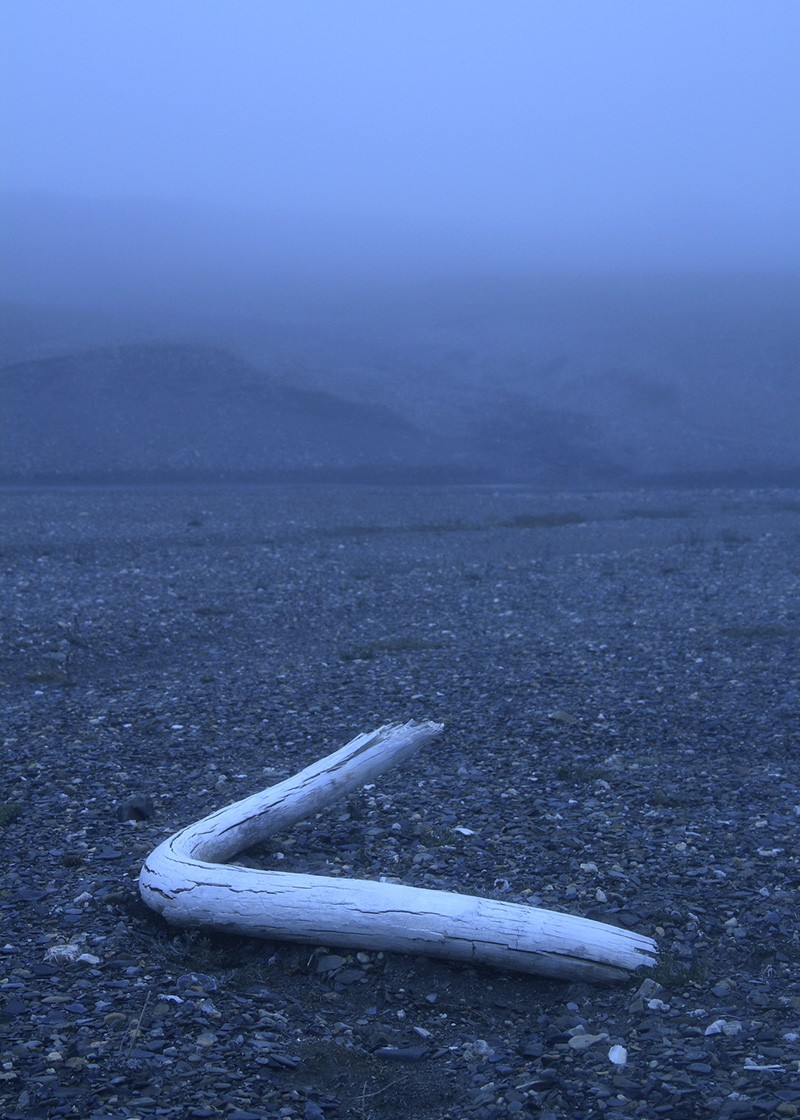White Science: Million-year-old mammoth genomes shatter record for oldest ancient DNA – My Comments
[Our science keeps moving forward. This is very important. And as always we do the IMPOSSIBLE! Jan]
Permafrost-preserved teeth, up to 1.6 million years old, identify a new kind of mammoth in Siberia.
The million-year-old genome is here. Mammoth teeth preserved in eastern Siberian permafrost have produced the oldest ancient DNA on record, pushing the technology close to — but perhaps not past — its limits.
Genomic DNA extracted from a trio of tooth specimens excavated in the 1970s has identified a new kind of mammoth that gave rise to a later North American species. The findings were published in Nature on 17 February1.
“I love the paper. I’ve been waiting for that paper for, what, eight years now,” says Ludovic Orlando, an ancient-DNA specialist at the Centre for Anthropobiology and Genomics of Toulouse in France, who co-led a 2013 effort that sequenced the previous oldest ancient DNA — a genome from a 560,000-to-780,000-year-old horse leg bone2. “I’m pleased to lose this record, because it was a heavy one,” he says.
Researchers had suspected that ancient DNA could survive beyond one million years, if the right sample could be found. Once an organism dies, its chromosomes shatter into pieces that get shorter over time. Eventually, the DNA strands become so small that — even if they can be extracted — they lose their information content.
Orlando’s team found that fragments as short as 25 DNA letters in their horse bone, from the Canadian Yukon Territory, could still be interpreted. They estimated that million-year-old remains preserved in the constant cold of permafrost — which slows DNA fragmentation — should also contain DNA fragments of that length. “My only doubt: does such a sample exist?” Orlando says.
Decadal dream
Love Dalén, an evolutionary geneticist at the Swedish Museum of Natural History (SMNH) in Stockholm, had been dallying with the idea of sequencing very old mammoth remains since he first encountered a collection of them, in 2007. The samples his team sequenced, one from an early woolly mammoth (Mammuthus primigenius) and two assigned to a precursor known as steppe mammoths (Mammuthus trogontherii), had been excavated by the Russian palaeontologist Andrei Sher.

Source: David Diez-del-Molino
Dalén hoped that DNA from the samples could capture the evolution of woolly mammoths and other species in action, but he was sceptical because of previous bad experiences with much younger remains found in permafrost. “It’s not like everything found in the permafrost always works. The vast majority of samples have crap DNA,” he says.
And indeed, two of the three mammoth molars from Sher’s excavations, retrieved from sediments more than than one million years old, contained so little DNA that Dalén says he would have discarded them had they been younger.
But thanks to advances in sequencing technology and bioinformatics, his team managed to obtain 49 million base pairs of nuclear DNA from the oldest sample, found near a village called Krestovka, and 884 million base pairs from another tooth, called Adycha. Analysis of the DNA suggested that the Krestovka sample was 1.65 million years old, and the Adycha sample around 1.3 million (see ‘Ancient genomes’). The third sample, a 600,000-year-old woolly mammoth tooth dubbed Chukochya, produced nearly 3.7 billion base pairs of DNA, more than the length of its 3.1-billion-base-pair genome.
From their shape, the two oldest teeth looked like they belonged to steppe mammoths, a European species that researchers think pre-dated woolly mammoths and Columbian mammoths (Mammuthus columbi), a North American species. But their genomes painted a more complicated picture. The Adycha specimen was part of the lineage that gave rise to woolly mammoths, but the Krestovka specimen clearly was not.
Dalén’s team found that it belonged to an entirely new lineage. “We can’t say it’s a different species, but it sure looks like it,” he says. Although the Krestovka sample is from Russia, he suspects the lineage became isolated from other steppe mammoths in North America. The team found that Columbian mammoths trace half their ancestry to the Krestovka mammoth lineage, and the other half to woolly mammoths. Dalén estimates that the two lineages mixed more than 420,000 years ago.

A tusk from a woolly mammoth.Credit: Love Dalén
The idea that new species can form through mixing — and not just splitting from a single parent species — is gaining currency among evolutionary biologists. But this is the first evidence for ‘hybrid speciation’ from ancient DNA, says Orlando. “This is amazing.”
Hendrik Poinar, an ancient-DNA specialist at McMaster University in Hamilton, Canada, says different mammoth species probably routinely hybridized when glacial expansion brought them together. His team has found evidence that later woolly and Columbian mammoths occasionally interbred.
The future of ancient DNA
Even though researchers have long been expecting a million-year-old genome, crossing that threshold is important, says Viviane Slon, a palaeogeneticist at Tel Aviv University in Israel. “There’s a difference between what we think is possible and actually showing it.”
Tom van der Valk, a bioinformatician at the University of Uppsala in Sweden who led the mammoth-tooth work with evolutionary biologists Patrícia Pečnerová and David Díez-del-Molino at the SMNH, hopes that it will encourage other labs. “It is a symbolic barrier that I hope can inspire and motivate other groups that have ideas about really deep-time sequencing.”
By crossing the million-year threshold, ancient-DNA researchers might be able to access the early histories of other mammals big and small, says Dalén. Very old permafrost samples of musk oxen, moose and lemmings are now on his lab’s radar.
The mammoth DNA does not represent the oldest biomolecular information from the fossil record. In 2016, researchers reported protein sequences from 3.8-million-year-old ostrich eggshells from Tanzania3, and in 2019 another team decoded proteins from a 1.77-million-year-old rhinoceros tooth from Georgia4. Protein sequences tend to be much less informative about an organism’s ancestry than DNA. But protein molecules are much hardier, so researchers can use them to glean insights from very old fossils found in places with no permafrost. The ostrich and rhino samples both come from archaeological sites famous for hominin remains.
The chances of finding million-year-old remains of ancient human relatives in the permafrost are very low, researchers say. But Dalén thinks that the right environment, such as a deep cave, could yield samples that old. Early Neanderthal remains from a Spanish cave dated to 430,000 years ago represent the oldest DNA from an ancient human relative discovered so far5. “Finding a hominin in the sort of ideal context for preservation as permafrost would be would be a dream,” says Slon.
As for the likely age limit of ancient DNA, Dalén says that’s easy to determine: “2.6 million years. That’s the limit of the permafrost. Before that, it was too warm.”

